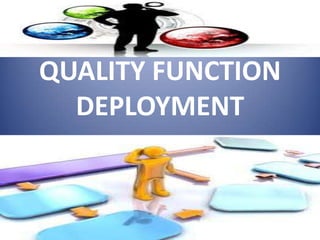Qfd
- 1. QUALITY FUNCTION DEPLOYMENT
- 2. INTRODUCTION • Initiated by Dr. Mizuno , professor emeritus of the Tokyo Institute of Technology • Standard practice by most leading organization • Disciplinary approach • Enables improvements • Customer driven product/process development
- 3. • First application at Mitsubishi, Japan 1972 • QFD implemented in production of mini vans by Toyota 1976 • 20% reduction in start up costs in launch of a new van 1979 • 38% reduction in costs 1982 • 68% cumulative reduction in costs 1984 • First introduced in USA 1984
- 4. DEFINITION • There is no single, right definition for QFD; this one captures its essential meaning: • A system for translating customer requirements into appropriate company requirements at each stage from research and product development to engineering and manufacturing to marketing/sales and distribution
- 5. KEY RATIONALE Customers are our number one concern. Satisfied customers keep us in business. Proactive product development is better than reactive product development. Quality is a responsibility of everyone in the organization. The QFD methodology helps an organization determine the most effective applications for many engineering and analytical tools such as: Design of Experiments, Failure Analysis and Statistical Process Control.
- 6. OVERVIEW CONVERTED CONVERTED • CUSTOMER TO • PART TO • PRODUCTION REQUIREMENTS CHARACTERISTICS REQUIREMENTS • COMPANY • MANUFACTURING MEASURES PROCESS CONVERTED CONVERTED DAY TO DAY TO TO
- 7. APPLICATION OF QFD • 3M CALLS THEM CUSTOMER DELIGHTS • UNEXPECTED, Satisfied PLEASANT SURPRISES Customer Spoken Measurable Range of Fulfillment Excitement QFD focuses on Needs Performance Needs Don’t Have Included and unmet Basic Don’t Do Do Well Needs Unspoken Performance Taken For granted Needs Basic Spoken If Not Met Basic Needs Dissatisfied Customer RECOGNIZE 1) The Impact of Needs on the Customer 2) That Customer Needs Change With Time 3) The impact of Communication of Customer Wants through out the Organization
- 8. THE QFD TEAM Marketing Production Design QFD Team Finance Quality
- 9. BENEFITS OF QFD FEWER AND LESS TIME IN EARLIER DEVELOPMENT CHANGES LOWER FEWER START START UP UP PROBLEMS COSTS FEWER FIELD SATISFIED PROBLEMS CUSTOMERS
- 10. DEFINITION OF HOUSE OF QUALITY • The house of quality translates the voice of the customer into design requirements that meet specific target values and matches those against how an organization will meet those requirements.
- 11. STRUCTURE OF HOUSE OF QUALITY • Exterior walls Customer requirements • Ceiling or second floor Technical descriptors • Interior walls Relationship between customer requirements and technical descriptors • Roof Interrelationship between technical descriptors
- 13. BUILDING A HOUSE OF QUALITY Steps in building a house of quality Develop a Develop a relationship Develop Develop List customer List technical interrelations matrix Competitive prioritized prioritized requirements descriptors hip matrix between assessments customer technical (WHATs) (HOWs) between WHATs requirements descriptors HOWs &HOWs
- 14. BUILDING A HOUSE OF QUALITY List Customer Requirements- It includes the list of goals/objectives. • This list is often refered as the WHATs that customer needs or expects in a particular product. → Primary list → secondary list
- 15. BUILDING A HOUSE OF QUALITY List Technical Descriptors • In this those engineering characteristics or technical descriptors (HOWs) are considered that will affect one or more of the customer requirements. • Counterpart characteristics are an expression of the voice of customer in technical language. • Primary technical descriptors • Secondary technical descriptors
- 16. BUILDING A HOUSE OF QUALITY Develop a relationship matrix between WHATs and HOWs • Compare the customer requirements and technical descriptors and determine their respective relationships. • Structuring an L-shaped diagram- This is meant to reduce the confusion associated with determining the relationship between customer requirements and technical descriptors . • Symbols – solid circle = ● (strong relation) single circle = ○ (medium relation) triangle = ∆ (weak relation) Blank = □ ( no relation)
- 17. BUILDING A HOUSE OF QUALITY Develop an interrelationship matrix between HOWs • The roof of house of quality ,called the correlation matrix ,is used to identify any interrelationship between each of the technical descriptors. • Symbols • solid circle = ● (strong positive relation) single circle = ○ (positive relation) single X = X (negative relation) Asterisk = * (strong negative relation)
- 18. BUILDING A HOUSE OF QUALITY Competitive assessment • It is a pair of weighted tables that depict item for item how competitive products compare with current organization products. • Types – 1.customer competitive assessment 2.Technical competitive assessment
- 19. BUILDING A HOUSE OF QUALITY Develop Prioritized Customer Requirements • The prioritized customer requirements make up a block of columns corresponding to each customer requirements in he house of quality to the right hand side of the customer competitive assessment. This column contains the following – - Importance to customer - Target value - Scale up factor - Sales point - Absolute weight
- 20. BUILDING A HOUSE OF QUALITY Develop prioritized technical descriptors • They make up a block of rows corresponding to each technical descriptors in the house of quality below the technical competitive assessment. • Degree of difficulty • Target value • Absolute weight • Relative weight
- 21. QFD PROCESS
- 22. PHASE 1 PRODUCT PLANNING
- 23. PHASE 2 PART DEVELOPMENT
- 24. PHASE 3 PROCESS PLANNING
- 25. PHASE 4 PRODUCTION PLANNING
- 26. IN A NUT SHELL
- 27. QFD Summary • Orderly Way Of Obtaining Information & Presenting It • Shorter Product Development Cycle • Considerably Reduced Start-Up Costs • Fewer Engineering Changes • Reduced Chance Of Oversights During Design Process • Environment Of Teamwork • Consensus Decisions • Preserves Everything In Writing

